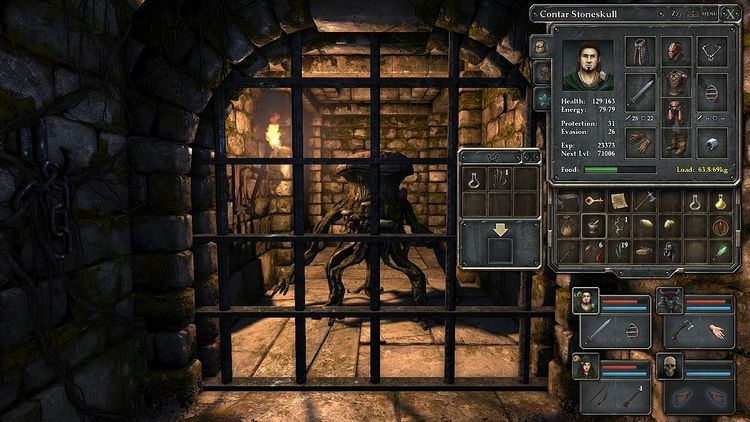 | ||
A dungeon crawl is a type of scenario in fantasy role-playing games in which heroes navigate a labyrinthine environment (a "dungeon"), battling various monsters, and looting any treasure they may find. Because of its simplicity, a dungeon crawl can be easier for a gamemaster to run than more complex adventures, and the "hack and slash" style of play is appreciated by players who focus on action and combat. The term can be used in a pejorative sense, since dungeon crawls often lack meaningful plot or logical consistency. The parody game Munchkin is about "the essence of the dungeon experience… Kill the monsters, steal the treasure, stab your buddy."
Contents
The first computer-based dungeon crawl was pedit5, developed in 1975 by Rusty Rutherford on the PLATO interactive education system based in Urbana, Illinois. Although this game was quickly deleted from the system, several more like it appeared, including dnd and Moria.
Some distinguish "dungeon crawlers" from rogue-likes and RPGs with stories and character-interaction, while others use the term to describe any game which features ample amounts of dungeon exploration (including Zork, Zelda and tabletop RPGs). More recently the term has come to mean 1st person RPGs, particularly ones which are aligned to a grid system and can be mapped on graph paper.
Dungeons & Dragons
Dungeon crawls in the role-playing game Dungeons & Dragons were influenced by J. R. R. Tolkien's The Hobbit and The Lord of the Rings, the Lankhmar short stories by Fritz Leiber, and by the "Cugel" stories from the Dying Earth books by Jack Vance.
According to Gary Gygax (in an interview with Dungeon #112), the first dungeon crawl was part of a wargame in which the invading force entered the enemy's castle through a former escape tunnel dug from the fortress's dungeon. The group had so much fun with this scenario that it was repeated over and over with increasingly complex dungeons until the wargame aspect of the game was dropped in favor of exploring the dungeon.
For pen and paper role-playing games, visual aids such as maps, models, or miniature figures are often used to represent the landscape of a dungeon crawl.
Video games
Due to their potential for simplicity and the limited expectations most players have for plot and logical consistency in dungeon crawls, they are fairly popular in role-playing video games. The roguelike genre is a common and typical example, with endless procedurally generated dungeon terrain and randomly placed monsters and treasures scattered throughout.
The 1980s may be seen as the "golden era" of this form of game. Games like Wizardry, The Bard's Tale, Cosmic Soldier, Might and Magic, Megami Tensei, Phantasy Star, Dungeon Master, Madou Monogatari and Gauntlet set the standards, while the primitive graphics were actually conducive to this style, due to the need for repetitive tiles or similar-looking graphics to create effective mazes. Some dungeon crawlers from this era also employed action role-playing game combat, such as Dragon Slayer and The Tower of Druaga.
Variations on the dungeon crawl trope can be found in other genres. Recent years have seen a modest resurgence in their popularity, particularly in Japan, largely due to the success of the Etrian Odyssey series by Atlus. Other handheld titles in later years include Beyond the Labyrinth, Deep Labyrinth, The Dark Spire, Orcs & Elves, and Class of Heroes, while on the PC the DarkLight Dungeon series and Legend of Grimrock have also been released. Other series related to the traditional dungeon crawl are The Elder Scrolls, King's Field, Demon's Souls and Dark Souls.
